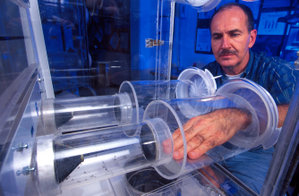Yellow fever
Yellow fever (also called yellow jack, black vomit, or sometimes American Plague) is an acute viral disease. It is still an important cause of hemorrhagic illness in several African and South American countries despite existence of an effective vaccine. In the past it was a source of several devastating epidemics. As of 2005, the World Health Organization (WHO) estimates that yellow fever causes 200,000 illnesses and 30,000 deaths every year in unvaccinated populations. more...
The disease is caused by an arbovirus of the family Flaviviridae, and is one of the smallest RNA viruses isolated by man.
Mosquitos are the primary vector in transmission of the disease from forest monkeys to humans and in person-to-person transmission. The mosquitos involved are Aedes simpsoni, Aedes africanus, and Aedes aegypti in Africa; and the Haemagogus and Sabethes genera.
The disease can remain locally unknown in humans for long periods of time and then suddenly break out in an epidemic fashion. In Central America and Trinidad this has been due to a form of the disease ("Jungle Yellow Fever") which is kept alive in Red Howler monkey populations and transmitted by Haemagogus mosquito species which only live in the canopy of rainforests. It is passed to humans when the tall rainforest trees are cut down. Infected woodcutters can then pass on the disease to others via species of Aedes mosquitoes which typically live at low altitudes, thus triggering an epidemic.
The course of the disease varies from an unapparent infection to an intense feverish illness with high mortality rate. There is a difference between disease outbreaks in rural or forest areas and in towns. Disease outbreaks in towns and non-native people are usually more serious.
After a 3 to 6 day incubation period the typical symptoms that arise are fever, muscle aches, headache and backache. Other symptoms may include a red tongue, flushed face, and reddening of the eyes. In a proportion of cases there is also involvement of internal organs - liver, kidneys and the heart. There may be hemorrhage from the digestive tract (bloody vomit). Later the disease is sometimes complicated by jaundice with liver failure (which causes yellow skin colour, hence the name "Yellow fever") and/or kidney insufficiency with proteinuria. If the disease progresses, delirium, seizures and coma ensue. Hypotension and dehydration are also common. Mortality is around 5%; although historically it has been much higher , .Patients who die usually do so within six to seven days from the onset.
Prevention
A vaccine for yellow fever was developed which gives a 10-year+ immunity from the disease and effectively protects people traveling to the affected areas whilst being a means to control the disease at the same time. Woodcutters working in jungle areas should be particularly targeted for vaccination. Insecticides, protective clothing and screening of houses are helpful but not always enough. In affected areas mosquito control methods have proved effective in decreasing the number of cases.
Public health
Yellow fever is one of the few diseases where some countries have a legal requirement that travellers to an endemic area require vaccination. These countries also usually have regulations requiring quarantine for people who arrive from yellow fever endemic areas who do not provide evidence of their having being vaccinated against yellow fever. This is because one of the vectors for transmission of yellow fever, the Aedes mosquito, exists in other tropical parts of the world (which are not endemic for yellow fever) and an outbreak could potentially erupt if the disease is inadvertently brought in
Read more at Wikipedia.org



